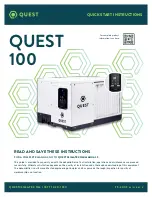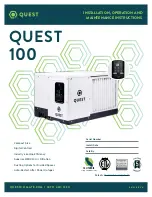
12
Pub. No. 2200772355 — October 2006
TROUBLESHOOTING
Before performing any maintenance, stop
the machine and disconnect it from the
power supply and from the compressed
air distribution network.
Table 3 — Troubleshooting Guide
Symptoms
Cause
Remedy
OPERATIONS MARKED WITH AN ASTERISK (*) MUST BE PERFORMED BY PROFESSIONALLY SKILLED PERSONNEL
APPROVED FROM THE MANUFACTURER.
A. No compressed air passes
through the dryer outlet.
1. The pipes are frozen inside.
*1a. The hot gas bypass valve is broken or
out of calibration.
1b. The room temperature is too low and
the evaporator’s piping is obstructed
with ice.
B. Presence of condensate in the
pipings.
1. The condensate separator does
not work correctly.
2. The dryer is working outside its
rating.
3. The dryer is working under bad
conditions for air-cooled
condenser.
1a. Clean the condensate drain filter.
*1b. Check the condensate drain.
2a. Check the flow rate of treated air.
2b. Check the room temperature.
2c. Check the air temperature at the dryer
inlet.
3a. Clean the condenser.
*3b. Check the operation and the
calibration of the fan cycling press.
Switch.
*3c. Check the operation of the fan.
C. The compressor head is very hot
>131 °F (55 °C).
1. The dryer is working outside its
rating.
2. The dryer is working under bad
conditions for air-cooled
condenser.
3. The cooling circuit is not
working with the right
refrigerant charge.
1a. Check the flow rate of treated air.
1b. Check the room temperature.
1c. Check the air temperature at the dryer
inlet.
2a. Clean the condenser.
*2b. Check the operation and the
calibration of the fan cycling press.
Switch.
*2c. Check the operation of the fan.
*3a. Check if there are leaks of
refrigerating gas.
*3b. Charge it again.


































